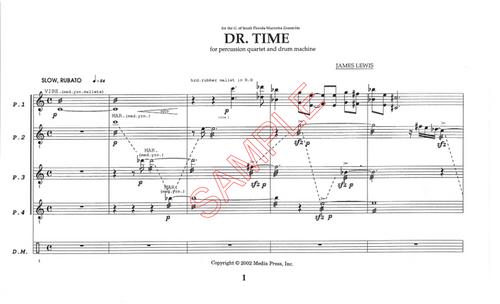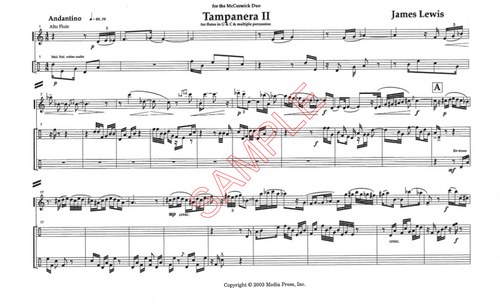For percussion quartet and drum machine (or drum set), includes score, parts and audio file. Dr. Time was written for the University of South Florida Marimba Ensemble. Mallet-keyboard instruments, plus a few suspended cymbals, are combined with a CD created using a drum machine. If you have a talented drum set player, Dr. Time can be performed using all acoustic instruments. Duration: ca. 5'
Print size: Legal (8.5 x 11")
Review from Percussive Notes:
Written for the University of South Florida Marimba Ensemble, "Dr. Time" is scored for percussion quartet and drum machine. Instruments required include four suspended cymbals (two small, one medium and one large), vibraphone, three marimbas, orchestra bells, xylophone and chimes. The drum machine part is written into the score (and recorded on a CD that is included), but there are a few small discrepancies between the CD version and the written part. According to the composer's notes, you can use a drumset player instead of the drum machine part. The piece begins with a slow, rubato introduction. Near the end of the introduction, the drum machine starts and the piece takes off in 4/8 time at eighth note = 134. The drum machine part is rock-oriented with typical cymbal, snare and bass drum sounds performing highly syncopated patterns. The acoustic parts are performed mostly on keyboard instruments in a highly dissonant musical style. Many interesting rhythmic patterns are juxtaposed with the drum machine. Hemiola is used to a great extent. The keyboard parts, while non-tonal in nature, are accessible for intermediate to advanced players. Most difficult passages are short and repeated. As the piece nears its end, an abrupt measure of silence is followed by the words "Dr. Time, one more time!" shouted by the members of the ensemble. The previous rock groove again commences and the piece is soon brought to an effective but unexpected end. Obviously meant to be a novelty piece, "Dr. Time" would make an excellent closer or encore number. Even so, there is much "meat" here for any ensemble to work through, and synchronizing the acoustic parts with the recorded part should improve the internal time of everyone in the ensemble.
-Tom Morgan







